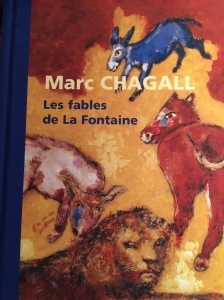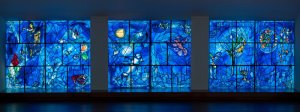
Le Loup et La Cigogne: Translating La Fontaine
Illustrations by Marc Chagall
In 1926, Marc Chagall, a Russian-French early modernist, painted over 100 gouache paintings, using opaque watercolors, and exhibited them in Paris, Bruxelles, and Berlin. After the success of this European tour, the Museum of Modern Art (MOMA ) in New York City, exhibited Chagall’s gouaches with des Fables of La Fontaine, which was a wonderful gift and introduction to the American art community. La Fontaine, a 17th century French fabulist, was one of the foremost men of letters in the Academie francaise and derived many of his fables from Aesop and Horace such as the Tortoise and the Hare, the Lion and the Mouse, and the Wolf and the Lamb, which have been read to les enfants across the world for many generations. La Loup et La Cigogne has been illustrated since the Middle Ages in Europe including one of the hydraulic statues in the Versailles labyrinth which was constructed by Louis XIV for his son’s education. However, for this post, I will focus on Chagall’s illustrations.
I first fell in love with the works of Marc Chagall after seeing the American Windows, his gift to the Art Institute of Chicago in 1976 of a stained-glass mural depicting the history of America to commemorate our country’s Bicentennial. I was therefore very pleased to find this unique work combining La Fontaine and Chagall in this wonderful children’s book to read to my grandchildren.

The translation is from 17th century French so, much like Shakespeare, many of the words are not found in modern dictionaries. Therefore, I took several liberties in the translation. For example, in the second line, La Fontaine describes the wolf as mangent…de frairie, which translates in modern French as eating in spawning season. The original French gives the idea as greedily gorging at a banquet, oblivious to others. This best described the wolf’s actions.
Secondly, La Fontaine’s phrase D’avoir de mon gosier retiré votre cou, which means « having my throat remain in your neck », was very hard to translate. After rescuing the wolf from choking to death, the stork asks for compensation. The wolf replies that it is payment enough that he didn’t eat the stork when his beak was down his throat. Therefore, it made more sense to me to translate as “having your beak down my throat”. I have also received a closer translation from one of my readers which is included in the translation. As is evident, it is essential for a parent to help interpret these fables to their children; however, who will interpret for the parent?!
As in my recent translations of French poets, I have tried to stay true to the original semantic fields of wording in French and therefore have not ventured to use the poetic rhyme and meter scheming. Therefore, it will sound choppy to the English reader.
If you enjoy the art of Marc Chagall or the classic works of La Fontaine, this beautifully illustrated book is easy to acquire; it is only $5.00 on Amazon and can be purchased in an English Translation (or you can use my subsequent translations in future blog posts!)
I hope you enjoy the first in a series of my translation of fables by La Fontaine!

Le Loup et La Cigogne by La Fontain
Illustrated by Marc Chagall
Les loups mangent gloutonnement,
Un loup donc étant de frairie,
Se pressa, dit-on, tellement
Qu’il en pensa perdre la vie.
Un os lui demeura bien avant au gosier.
De bonheur pour ce loup, qui ne pouvait crier,
Près de là passe une cigogne.
Il lui fait signe, elle accourt.
Voilà l’opératrice aussitôt en besogne.
Elle retira l’os ; puis pour un si bon tour
Elle demanda son salaire.
« Votre salaire ? dit le loup :
Vous riez, ma bonne commère.
Quoi ! ce n’est pas encor beaucoup
D’avoir de mon gosier retiré votre cou ?
Allez, vous êtes une ingrate ;
Ne tombez jamais sous ma patte. »
My English Translation :
The wolves were voraciously eating.
One wolf, which was greedy,
Engrossed, it is said, so much
That he nearly lost his own life.
A bone remained too long in his throat.
Fortunately, for this wolf who could not scream,
A stork passed nearby.
He beckons her, and she ran to him.
Here the operator immediately went to work.
She removed the bone; Then for a good turn
She asked for her salary.
” Your salary ? Said the wolf:
You laugh, my good word.
But What! It is not enough
That you got to take your neck out of my mouth?
Come now, you are an ungrateful;
Never fall under my paw. ”
La Fontaine’s Moral: It is sometimes dangerous to help the wicked!

Marc Chagall, Les fables de La Fontaine. Céret, Musée D’Art Moderne, 28 Octobre 1995-8 Janvier 1996. Réédité a L’Occasion de L’Exposition Chagall Connu et Inconnu.Éditions de la Réunion des musées nationaux, Paris,
49 rue Étienne-Marcel, 75001 Paris
Further Reading on Marc Chagall:
- (English) https://frenchquest.com/2016/07/01/the-history-and-civilization-of-france-in-the-20th-century-the-belle-epoque/
- (French) https://frenchquest.com/2016/06/11/lhistoire-et-la-civilisation-de-la-france-sur-le-xxe-siecle-la-belle-epoque/
Further Reading on Translating:
- Zeteojournal.com , William Eaton, Editor
Copyright 2016 by Robyn Lowrie. May be quoted in part or full with attribution to Robyn Lowrie (www.frenchquest.com)

Interesting to see an English translation of this old, well-known tale. Correct the moral: NEVER help the wicked. 😉
Bon week-end.
With Illustrations by Marc Chagall! Quite a treasure